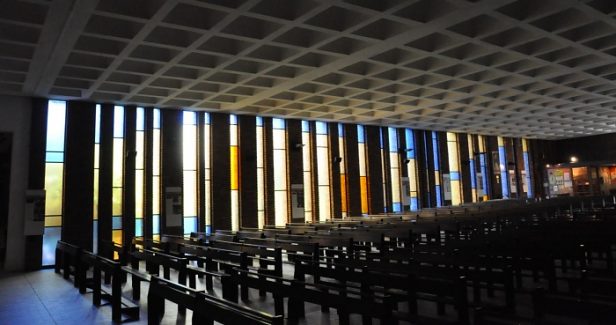Conçue par l'architecte Roland Dubrulle l'église Saint Albert le Grand possède une ossature en béton armé recouverte de briques rouges qui - ne serait la sobre croix métallique - la rend quasiment invisible au coté de la grande barre d'hlm voisine. Son originalité se situe à l'intérieur avec une nef dégagée de tout pilier et un sol en pente de l'entrée jusqu'au chœur à la manière d'un amphithéâtre. La verrière, à droite sur toute la longueur de l'église, représente un énorme poisson symbole des premiers chrétiens.

L'église a été construite en 1968 à la suite du réaménagement du quartier Glacière. Elle remplace l'ancienne chapelle Sainte-Agonie qui cacha des aviateurs anglais lors de l'occupation allemande en 1942. L'histoire (et Wikipedia :-) rapporte que Sœur Marie-Vianney, tourière chargée d'ouvrir la porte, eut la présence d'esprit de proposer un café dans le parloir aux soldats à 5 heures du matin le jour de la grande fouille du quartier. Les Anglais, réveillés en urgence, eurent juste le temps de gagner leur cache sous l'autel en traversant la chapelle.
 Saint Albert le Grand était un religieux dominicain né en Bavière vers 1206. Cet érudit vécut à Paris durant 3 ans, et eut pour élève saint Thomas d'Aquin. Il écrivit notamment un vaste traité de commentaires d'Aristote et une encyclopédie sur toute la faune d'Europe du Nord. Et comme il lui restait un petit peu de temps il fit de même pour tous les minéraux et les végétaux connus à l'époque. A Paris, ce "docteur universel" laisse également son nom à la rue Maitre-Albert et à la place Maubert.
Saint Albert le Grand était un religieux dominicain né en Bavière vers 1206. Cet érudit vécut à Paris durant 3 ans, et eut pour élève saint Thomas d'Aquin. Il écrivit notamment un vaste traité de commentaires d'Aristote et une encyclopédie sur toute la faune d'Europe du Nord. Et comme il lui restait un petit peu de temps il fit de même pour tous les minéraux et les végétaux connus à l'époque. A Paris, ce "docteur universel" laisse également son nom à la rue Maitre-Albert et à la place Maubert.
L'église accueille la communauté latino-américaine de Paris, ainsi sa chapelle latérale se teinte de couleurs vives avec des image et des statues très réalistes dans le style péruvien.
Pour une église catholique, l'indice se doit d'être dans le thème… bon jeu.
English
Designed by architect Roland Dubrulle, the church Saint Albert the Great has a reinforced concrete frame covered with red bricks which makes it virtually invisible to the side of the large hlm bar neighbor. Its originality lies inside with an open nave with no pillars and a sloping floor from the entrance to the choir in the manner of an amphitheater. The skylight, all the lenght of the church is a huge fish, symbol of the early Christians.
The church was built in 1968 following the redevelopment of the district Glacière. It replaces the old chapel of St. Agony which hide British airmen during the German occupation in 1942. the history (and wikipedia :-) reports that Sister Marie-Vianney, portress responsible for opening the door, had the presence of mind to offer a coffee to soldiers at 5 am the day of the big dig in the district. The english, awakened in emergency, had just the time to hide under the altar in the chapel.
It bears the name of St. Albert the Great, born in Bavaria around the year 1200. This scholar Dominican lived in Paris for 3 years, and had a pupil Thomas Aquinas. He notably wrote a comprehensive treatise of commentaries on Aristotle (26 books) and an encyclopedia on all the wildlife of Northern Europe. And as he still had a little time he did the same for minerals and plants. In Paris, this "Universal Doctor" also gave his name to the street Maitre Albert and the Place Maubert.
The church hosts the Latin American community in Paris, and the side chapel is dyed in bright colors with images and very realistic statues Peruvian style.
For a church, the hint must be in subject ... have a good game